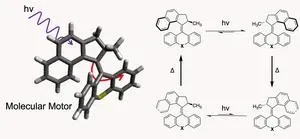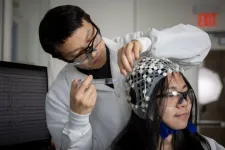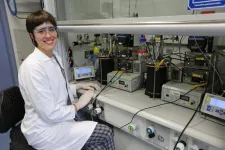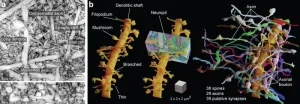Rice University scientists have used light-activated molecular machines to trigger intercellular calcium wave signals, revealing a powerful new strategy for controlling cellular activity, according to a new study published in Nature Nanotechnology. This technology could lead to improved treatments for people with heart problems, digestive issues and more.
“Most of the drugs developed up to this point use chemical binding forces to drive a specific signaling cascade in the body,” said Jacob Beckham, a chemistry graduate student and lead author on the study. “This is the first demonstration that, instead of chemical force, you can use mechanical force ⎯ induced, in this case, by single-molecule nanomachines ⎯ to do the same thing, which opens up a whole new chapter in drug design.”
Scientists used small-molecule-based actuators that rotate when stimulated by visible light to induce a calcium-signaling response in smooth muscle cells.
We lack conscious control over many of the critical muscles in our body: The heart is an involuntary muscle, and there is smooth muscle tissue lining our veins and arteries, controlling blood pressure and circulation; smooth muscle lines our lungs and intestines and is involved in digestion and breathing. The ability to intervene in these processes with a molecular-level mechanical stimulus could be game-changing.
“Beckham has shown that we can control, for example, cells’ signaling in a heart muscle, which is really interesting,” said James Tour, Rice’s T. T. and W. F. Chao Professor of Chemistry and a professor of materials science and nanoengineering.
“If you stimulate just one cell in the heart, it will propagate the signal to the neighboring cells, which means you could have targeted, adjustable molecular control over heart function and possibly alleviate arrhythmias,” Tour said.
Activated by quarter-second-long light pulses, the molecular machines allowed scientists to control calcium signaling in a cardiac myocyte cell culture, causing the inactive cells to fire.
“The molecules essentially served as nano-defibrillators, getting these heart muscle cells to start beating,” Beckham said.
The ability to control cell-to-cell communication in muscle tissue could be useful for the treatment of a wide range of diseases characterized by calcium-signaling dysfunction.
“A lot of people who are paralyzed have huge digestive problems,” Tour said. “It would be a big deal if you could alleviate these issues by causing those relevant muscles to fire without any kind of chemical intervention.”
The molecule-sized devices activated the same calcium-based cellular signaling mechanism in a live organism, causing whole-body contraction in a fresh-water polyp, or Hydra vulgaris.
“This is the first example of taking a molecular machine and using it to control an entire functioning organism,” Tour said.
Cellular response varied based on the type and intensity of the mechanical stimulation: Fast, unidirectionally rotating molecular machines elicited intercellular calcium wave signals, while slower speeds and multidirectional rotation did not.
Moreover, adjusting the intensity of the light allowed scientists to control the strength of the cellular response.
“This is mechanical action at the molecular scale,” Tour said. “These molecules spin at 3 million rotations per second, and because we can adjust the duration and intensity of the light stimulus, we have precise spatiotemporal control over this very prevalent cellular mechanism.”
The Tour lab has shown in previous research that light-activated molecular machines can be deployed against antibiotic-resistant infectious bacteria, cancer cells and pathogenic fungi.
“This work expands the capabilities of these molecular machines in a different direction,” Beckham said. “What I love about our lab is that we are fearless when it comes to being creative and pursuing projects in ambitious new directions.”
“We’re currently working towards developing machines activated by light with a better depth of penetration to really actualize the potential of this research. We are also looking to get a better understanding of molecular-scale actuation of biological processes.”
The research was supported by the Discovery Institute, the Robert A. Welch Foundation (C-2017-20190330), the National Science Foundation Graduate Research Fellowship Program, the DEVCOM Army Research Laboratory (Cooperative Agreement W911NF-18-2-0234) and the European Union’s Horizon 2020 (Marie Sklodowska-Curie grant agreement 843116).
-30-
This release can be found online at news.rice.edu.
Follow Rice News and Media Relations via Twitter @RiceUNews.
Peer-reviewed paper:
Molecular Machines Stimulate Intercellular Calcium Waves and Cause Muscle Contraction | Nature Nanotechnology | DOI: 10.1038/s41565-023-01436-w
Authors: Jacob Beckham, Alexis van Venrooy, Soonyoung Kim, Gang Li, Bowen Li, Guillaume Duret, Dallin Arnold, Xuan Zhao, John Li, Ana Santos, Gautam Chaudhry, Dongdong Liu, Jacob Robinson and James Tour
https://www.nature.com/articles/s41565-023-01436-w
Video:
https://youtu.be/ubNhBFhI8MQ
CAPTION: Molecular motor-induced "beating" motion and calcium wave oscillation in cardiac myocyte cells (stimulation applied at the 30 second mark ⎯ timestamp in top left corner)
(Video edited by Brandon Martin/Rice University)
Image downloads:
https://news-network.rice.edu/news/files/2023/05/230504_Tour_Beckham-Nature-Nanotechnology_LG.jpg
CAPTION: James Tour and Jacob Beckham. (Photo by Gustavo Raskosky/Rice University)
https://news-network.rice.edu/news/files/2023/05/230504_JBeckham-Nature-Nanotechnology_LG.jpg
CAPTION: Jacob Beckham is a Rice U. chemistry graduate student and a lead author on the study. (Photo by Gustavo Raskosky/Rice University)
https://news-network.rice.edu/news/files/2023/07/NatNano.jpg
CAPTION: Model of a molecular motor (left) and its rotation cycle. (Image courtesy of the Tour lab/Rice University)
Related stories:
Molecular machines could treat fungal infections:
https://news.rice.edu/news/2023/molecular-machines-could-treat-fungal-infections
New weapon targets antibiotic resistance:
https://news.rice.edu/news/2022/new-weapon-targets-antibiotic-resistance
Bacteria-killing drills get an upgrade:
https://news.rice.edu/news/2022/bacteria-killing-drills-get-upgrade
Chemists build a better cancer-killing drill:
https://news2.rice.edu/2019/05/28/chemists-build-a-better-cancer-killing-drill-2/
Deadly ‘superbugs’ destroyed by molecular drills:
https://news2.rice.edu/2019/12/12/deadly-superbugs-destroyed-by-molecular-drills/
Motorized molecules drill through cells:
https://news2.rice.edu/2017/08/30/motorized-molecules-drill-through-cells-2/
Links:
Tour Group: https://www.jmtour.com/
Rice Department of Chemistry: https://chemistry.rice.edu/
Wiess School of Natural Sciences: https://naturalsciences.rice.edu/
Located on a 300-acre forested campus in Houston, Rice University is consistently ranked among the nation’s top 20 universities by U.S. News & World Report. Rice has highly respected schools of Architecture, Business, Continuing Studies, Engineering, Humanities, Music, Natural Sciences and Social Sciences and is home to the Baker Institute for Public Policy. With 4,552 undergraduates and 3,998 graduate students, Rice’s undergraduate student-to-faculty ratio is just under 6-to-1. Its residential college system builds close-knit communities and lifelong friendships, just one reason why Rice is ranked No. 1 for lots of race/class interaction and No. 4 for quality of life by the Princeton Review. Rice is also rated as a best value among private universities by Kiplinger’s Personal Finance.
If you do not wish to receive news releases from Rice University, reply to this email and write “unsubscribe” in the subject line. Office of News and Media Relations – MS 300, Rice University, 6100 Main St., Houston, TX 77005.
END







